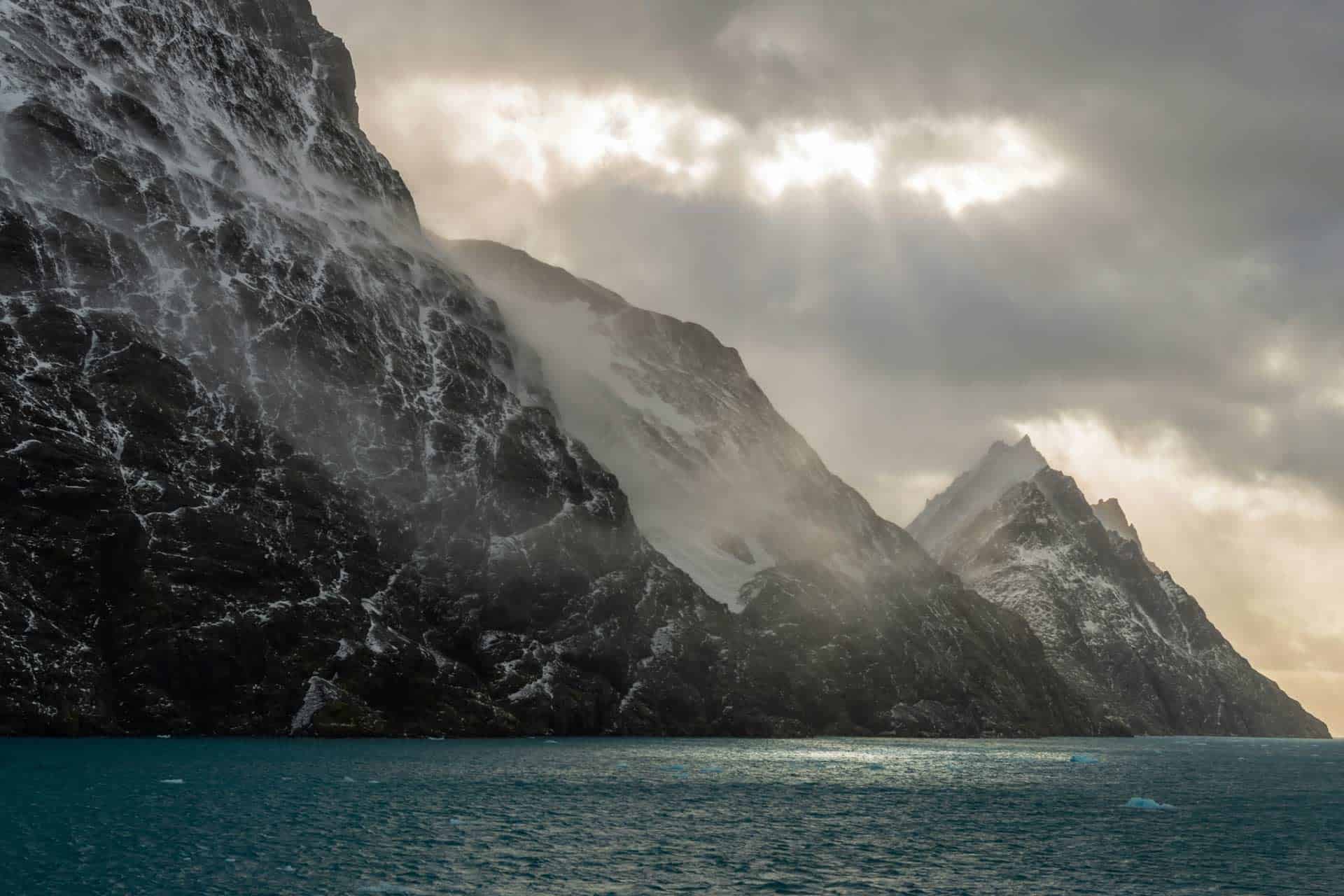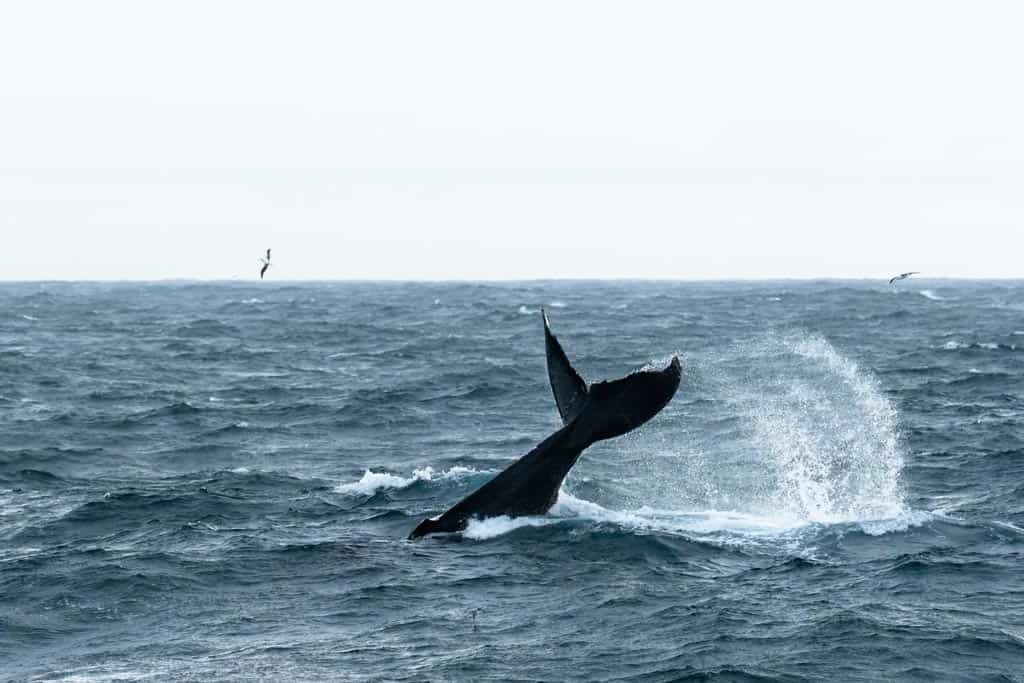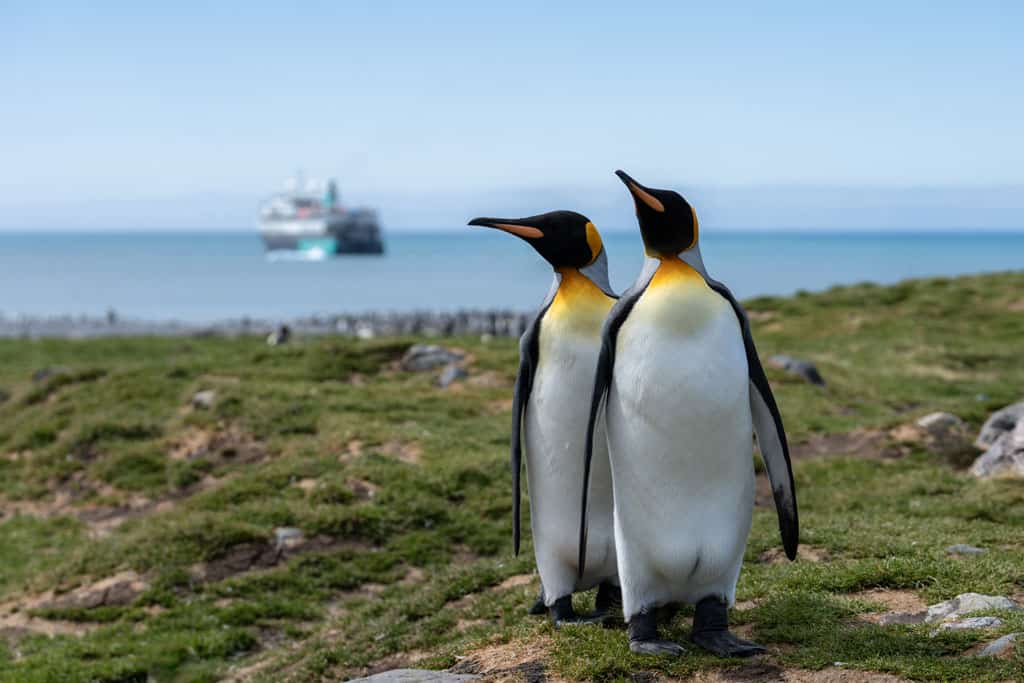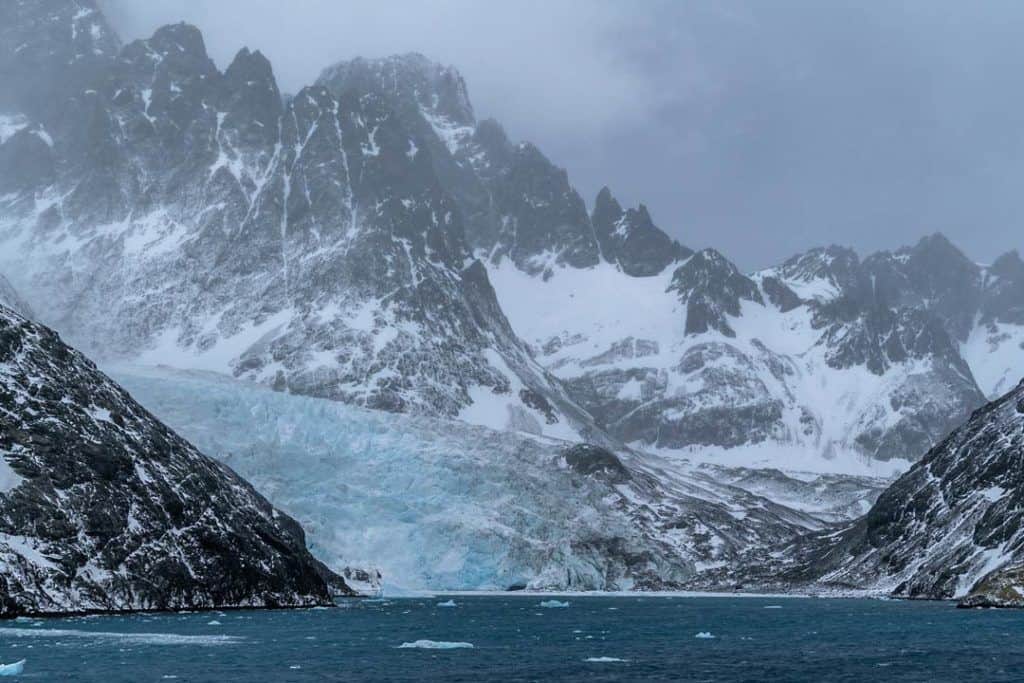
If you’re visiting South Georgia, don’t miss a visit to Drygalski Fjord! This majestic natural landmark boasts some of the best views in the area.
To see breathtaking glaciers, frolicking penguins, and rugged mountains against the backdrop of the Southern Ocean, be sure to check out Drygalski Fjord!
Located off the southeastern coast of South Georgia, this beautiful inlet is framed by dramatic mountains and ice-covered cliffs.
This remote environment is rich in wildlife, with seals, penguins, and seabirds commonly seen along its shores and on the ice.
The stunning scenery and abundant wildlife make Drygalski Fjord a highlight for visitors on polar expedition cruises.
Read our full travel guide to South Georgia for more tips and recommendations!
Complete Guide to Drygalski Fjord, South Georgia
Here is everything you need to know about the gorgeous Drygalski Fjord on South Georgia Island! A journey to South Georgia, one of the most pristine environments in the world, is well worth the trek.
Important Note! Before you book any international trip, we honestly recommend getting travel insurance. You never know when things will go wrong, and medical bills can add up quickly if you get sick or injure yourself overseas.
Our personal recommendation based on our own experience is World Nomads.
Where is Drygalski Fjord?
Drygalski Fjord sits at the southeastern tip of South Georgia Island in the South Atlantic Ocean.
It lies near Cape Disappointment, opening into the Southern Ocean, and is surrounded by the incredible views of South Georgia’s mountainous terrain.
Reaching Drygalski Fjord typically takes several days by ship, depending on the starting point.
From the Falkland Islands, it usually takes 3 to 4 days of sailing across the South Atlantic to reach South Georgia Island.
From Ushuaia, Argentina, it can take 4 to 6 days to reach South Georgia.
Once at South Georgia, reaching Drygalski Fjord itself may take another day or two, as ships often visit other key landing sites (like Grytviken or St. Andrews Bay) before circling to the island’s southeastern end.
Because Drygalski Fjord is one of the southernmost points of the island, it’s often visited toward the end of the itinerary, depending on sea ice and weather.
 The beauty of Drygalski Fjord
The beauty of Drygalski Fjord
Drygalski Fjord Landscape and Nearby Landmarks
As part of the sub-Antarctic region, the fjord is filled with glaciers and sheer cliffs, creating a narrow and enclosed passageway.
The fjord stretches about 14 kilometers inland, with some other notable landmarks nearby:
Risting Glacier: Located at the head of the fjord, this massive glacier often calves into the sea.
Mount Worsley: Part of the rugged mountain terrain nearby, this peak honors Frank Worsley, the captain of Shackleton’s Endurance.
Cooper Bay: Situated northeast of Drygalski Fjord, Cooper Bay is known for its rich wildlife, including colonies of macaroni and chinstrap penguins, and its steep, scenic cliffs.
Larsen Harbour: A narrow, glacier-fed inlet branching off the west side of the fjord. Larsen Harbour is often used as a safe anchorage for small vessels.
Cape Disappointment: A headland named by Captain James Cook during his 1775 voyage, when he realised South Georgia was not part of the fabled Southern Continent that he was looking for. A fitting name for his emotions at the time!
Read next: The Best Time To Visit South Georgia
History of Drygalski Fjord
The history of Drygalski Fjord is closely tied to the era of polar exploration and early scientific expeditions in the South Atlantic.
It was named after Professor Erich von Drygalski, a German geographer and polar scientist who led the First German Antarctic Expedition (1901–1903) aboard the ship Gauss.
Although Drygalski himself never visited South Georgia, the fjord was named in his honour by later German explorers who admired his contributions to polar research.
The fjord and surrounding region were charted in more detail during the early 20th century, particularly by the Discovery Investigations—a British scientific program studying the Southern Ocean and whaling grounds around South Georgia from the 1920s onward.
While Drygalski Fjord never hosted permanent settlements or whaling stations, it was occasionally visited by vessels seeking shelter or conducting scientific surveys.
Today, its history is preserved in its name and in its role as a destination for modern expedition cruise ships.
Read next: 24 Best Places To Visit In Antarctica
Wildlife at Drygalski Fjord
The wildlife at Drygalski Fjord is incredible, with lots of amazing creatures that are well-adapted to the harsh sub-Antarctic environment.
Though the steep terrain filled with glaciers limits extensive breeding colonies, the fjord and its surrounding waters support a rich array of marine and bird life.
 Humpback whale off the coast of South Georgia
Humpback whale off the coast of South Georgia
Seals
Weddell seals, fur seals, and elephant seals often haul out on the rocky shores and floating ice around the fjord.
Weddell seals, in particular, are well-suited to the icy fjord environment and may be seen resting near the glacier fronts. Larsen Harbour, within Drygalski Fjord, is one of the few places where Weddell seals are known to breed on South Georgia.
Elephant seals and fur seals don’t breed in the area, but are still commonly spotted!
Penguins
Large penguin colonies are rare in Drygalski Fjord because of the steep and sometimes treacherous cliffs.
But chinstrap and macaroni penguins are frequently spotted in nearby areas like Cooper Bay, and individual penguins may be seen swimming or exploring rocky outcrops.
Gentoo penguins are also found on South Georgia and can occasionally be spotted in surrounding coastal regions.
South Georgia is also famous for its incredible colonies of king penguins. Though the colonies mostly congregate in flat, grassy places like St. Andrews Bay, Gold Harbour, and Salisbury Plain, king penguins can occasionally be spotted in the waters around Drygalski Fjord.
 King penguins on South Georgia
King penguins on South Georgia
Seabirds
The skies and cliffs around the fjord are frequented by sub-Antarctic bird species such as light-mantled sooty albatross, snow petrels, wilson’s storm petrels, and skuas.
These birds nest on nearby cliffs to escape the strong winds, but you can also see them flying on calmer days or hunting in the sea.
Whales and dolphins
The deep, nutrient-rich waters around South Georgia, including those near Drygalski Fjord, can attract humpback whales, fin whales, and orca, especially during the austral summer when feeding conditions are ideal.
Zodiac cruises around the island are amazing ways to see the beauty of the marine life on your trip!
Read about the best animals to spot around Antarctica!
How to visit Drygalski Fjord, South Georgia
Visiting Drygalski Fjord, South Georgia, is a rare and awe-inspiring experience, typically possible only as part of a polar expedition cruise that includes Antarctica.
Booking your cruise
The only practical way to reach the fjord is by booking a multi-day expedition cruise that includes South Georgia in its itinerary. These cruises often depart from Ushuaia, Argentina, or occasionally from Stanley in the Falkland Islands, and they usually include Antarctica as well.
Not all South Georgia cruises visit Drygalski Fjord, as it lies at the island’s remote southeastern tip. Look for itineraries that include specific mentions of Drygalski Fjord, Cape Disappointment, or Larsen Harbour, which are all in the area.
Find more info in our guide to cruise expeditions in Antarctica!
Local weather conditions
Due to its steep cliffs, strong wind, icy conditions, and lack of flat ground, most visits to Drygalski Fjord involve Zodiac cruises.
This type of trip means you will explore the fjord from small inflatable boats, getting close to glaciers, icebergs, and wildlife. Going ashore is rare.
Expedition routes are always subject to weather, and snow, wind, or sea ice can disrupt a trip at any given moment. So even if Drygalski is on the planned itinerary, a visit isn’t guaranteed.
Operators prioritise safety for everyone and adapt routes daily!
 The fjord can be harder to pass through in stormy weather.
The fjord can be harder to pass through in stormy weather.
Travel Season
The best time to visit Drygalski Fjord is during the austral summer, from November to March, when the weather is not too cold and wildlife activity is at its peak.
November to early December: This is early in the season, when the landscape is still snowy and dramatic. Animals are active, which is an incredible sight. Fewer ships visit during this time, offering a quieter experience.
Mid-December to January: Peak summer brings the warmest temperatures (still cold by most standards), longer daylight hours, and increased wildlife activity. Penguin chicks hatch, and many species are actively feeding.
February to March: This is the best time for whale sightings, as species like humpbacks and orcas are more common in South Georgia’s waters. Penguin colonies are still active, and the melting icebergs reveal more of the land.
DISCLAIMER: Some of the links in this article are affiliate links, which means if you book accommodation, tours or buy a product, we will receive a small commission at no extra cost to you. These commissions help us keep creating more free travel content to help people plan their holidays and adventures. We only recommend the best accommodations, tours and products that ourselves or our fantastic editorial team have personally experienced, and regularly review these. Thanks for your support, kind friend!
Please visit:
Our Sponsor
